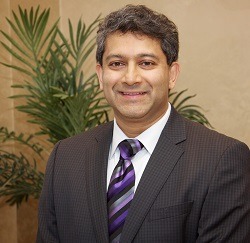by Sumeet Patel, Azim Shaikh and Mubin Syed

The GET LEAN (Gastric artery embolization trial for the lessening of appetite nonsurgically) study shows promising six-month preliminary data with an average body weight loss of around 20lbs and no serious adverse events. The first diabetic patient was treated using embolization and we saw an improvement in her glycosylated haemoglobin, HbA1c, levels at six months, write Sumeet Patel, Azim Sheikh and Mubin Syed.
GET LEAN is a pilot study designed to collect safety and efficacy data in patients undergoing left gastric artery embolization for morbid obesity in the USA. As a secondary goal, the pilot study seeks to obtain quality of life data. It is not designed to achieve new indications for Bead Block (BTG), which is the embolic agent used in the study. Researchers treated four white patients (three women) with an average age of 41 years and mean weight of 259.3lbs. The patients had a mean body mass index (BMI) of 42.4 kg/m2 underwent a left gastric artery embolization procedure with 300–500μm Bead Block particles via right common femoral or left radial artery approach. As reported last year in The Journal of Vascular and Interventional Radiology (JVIR), the follow-up included upper endoscopy at three days and 30 days if necessary, and a gastric emptying study at three months.
The results of the GET LEAN study at six months reveal an average weight loss of 20.3lbs (n=4; range, -6 to -38lbs), or -8.5% (range, -2.2% to -19.1%). Average excess body weight loss at six months was -17.2%. There were no serious adverse events. There were three minor complications, superficial gastric ulcerations that healed by 30 days, and did not require hospitalisation. The results showed that left gastric artery embolization appears to be safe in the intermediate term for weight loss in morbidly obese patients. The quality of life measures showed a general trend toward improvement. We also found that the radial artery approach appears to be feasible and this may have implications as a safer more convenient access site in this population. All procedures in the study were performed in an outpatient setting.
The first diabetic patient was treated in this study under US FDA investigational device exemption (IDE) clearance and had a weight loss of 28lbs with an associated drop in her HbA1c.
The study has recently received FDA IDE clearance to treat anatomic variants that occur in as many as 15% of the population.

Obesity is one of the largest public health concerns in the USA, and indeed, worldwide. In fact, 1/3 of the world population is either obese or overweight according to The Lancet. Obesity predisposes patients to a variety of maladies, including adult-onset diabetes, cardiovascular disease, hypertension, malignancy, obstructive sleep apnoea, venous stasis disease and osteoarthritis. Morbid obesity affects 6.6% of the US population. Bariatric surgery, the standard of care, is often performed for morbidly obese patients. This is because in these patients, conservative weight loss measures such as diet and exercise often fail. Unfortunately, these surgical treatments have known serious complications, including anastomotic leaks, bowel obstruction, deep vein thrombosis, pulmonary embolism, gastrointestinal bleeding, dumping syndrome, and anaesthesia risks that result in morbidity and mortality. The 30-day mortality rate from bariatric surgery is approximately 0.31% as of 2014, which is less than previously reported in 2004. Despite this, the reoperation rate is 7% and the total overall complication rate is 17%. It is estimated that only 1% of eligible patients choose to have bariatric surgery.
Sumeet Patel and Azim Shaikh are with the research team at Dayton Interventional Radiology, Dayton, USA. Mubin Syed is an interventional radiologist, president and coowner of Dayton Interventional Radiology. He received the runner’s up award Editor’s Award 2016 for Distinguished Clinical Study at the SIR 2017 Annual Scientific Meeting in Washington, DC, USA. The authors have reported no disclosures pertaining to this article.













